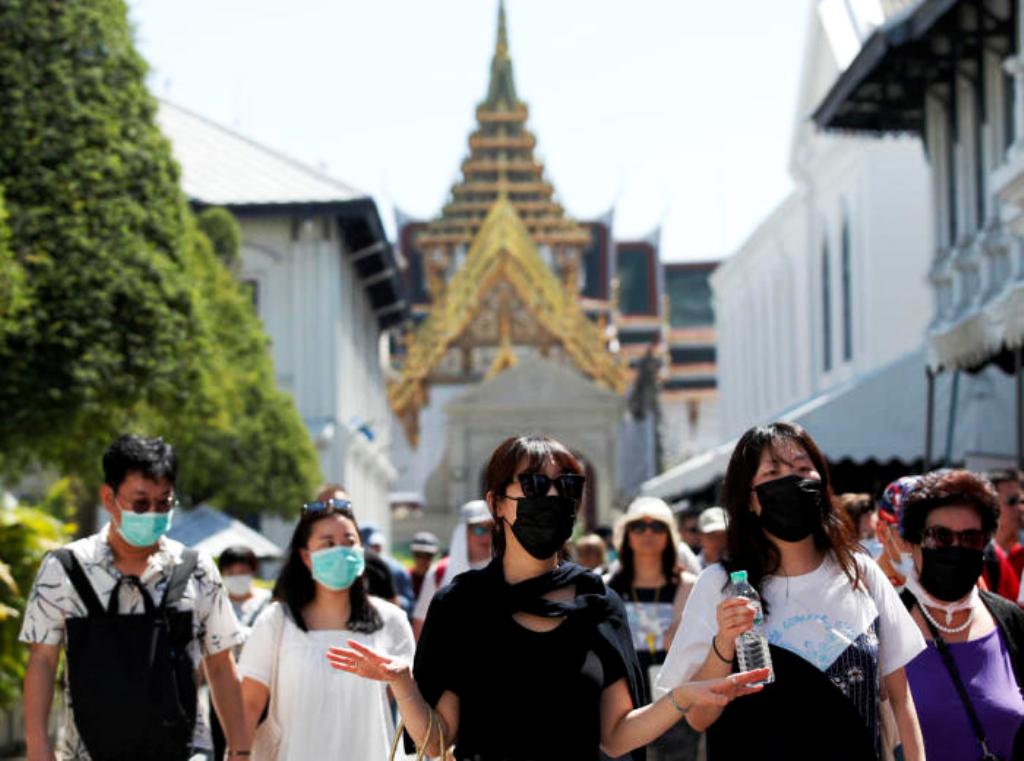Business
Thai Economy Was Sick Way Before the Novel Coronavirus
Now add in Beijing’s newly imposed restrictions on Chinese travelers, who account for the lion’s share of arrivals, plus the knock-on effect on other tourists, and a recession begins to look imminent.

Despite Thailand having the largest amount of novel coronavirus cases outside of China, the Thai economy was sick even before the virus outbreak. Unfortunately, the export-reliant $500 billion Thai economy has been plagued by a strong baht and US-China trade war.
Now add in Beijing’s newly imposed restrictions on Chinese travelers, who account for the lion’s share of arrivals, plus the knock-on effect on other tourists, and a recession begins to look imminent.
Thailand has lagged its Southeast Asian neighbors for some time. While political upheaval has been a major drag, there are others too: an aging population, poor productivity, flat-lining consumption and hefty household debt. The central bank now expects GDP growth of 2.5% for 2019. That’s considerably worse than even lackluster peers like Malaysia and Indonesia, and the country’s weakest pace since 2014, the year a military junta took power.
Exports also shrank in 2019, with shipments in the key car making industry declining. Thailand is a regional hub for vehicle manufacturers like Nissan Motor Co.. Which have been affected by poor demand in major markets such as China, Bloomberg reports.
The high baht hurt Thai economy
The Thai currency outperformed last year despite policymakers’ efforts, on the back of a yawning current account surplus, weak inflation and near-record foreign exchange reserves. The baht’s recent weakening has been one of the few positive side-effects of the coronavirus epidemic. In November, Thailand relaxed rules on capital outflows to ease upward pressure. But central bank officials know that too much tinkering in the market could prompt Washington to label it a currency manipulator.
Meanwhile, fiscal stimulus, including an infrastructure drive, was held up by wrangling around the 2020 government budget. An interest rate cut this coming week, to a record low of 1%, looks likely. Which will also affect the Thai economy.
So the year had already started poorly. Now, with 19 confirmed cases of novel coronavirus, most of them Chinese travelers, and the illness spreading fast, it looks a whole lot worse. In the third quarter, the economy expanded only 0.1% compared to the previous three months. Analysts say fourth-quarter numbers, reported this month, could show a slip into negative territory. A further contraction in the first three months of 2020 would put Thailand into a technical recession.
The first and most direct factor is tourism. Depending on how you measure it, the industry accounts for roughly a fifth of Thailand’s GDP. Visitor numbers were already depressed by the strong baht, which made other tropical destinations cheaper. Chinese tourists, who were supposed to flock back as the impact of a 2018 boat disaster waned, were trickling in only slowly.
China’s Tour Ban
That makes China’s restrictions to contain the pandemic all the more painful. On Jan. 24, travel agencies were ordered to stop selling tour packages overseas. While many more Chinese now venture abroad alone, roughly half still go with groups. Thailand’s finance ministry warned last Wednesday that the virus and related bans could have a three-month impact, meaning 400,000 fewer visitors. Tourism authorities have forecast an even steeper Chinese drop.
For Thailand, that’s more than a peak-season blow. China accounts for the largest number of visitors – some 11 million traveled last year, according to Thai authorities. They also splurge more per head than any other nationality. Amounting to an estimated total of almost $18 billion in 2019. That’s just over a quarter of spending by overseas visitors, as reported by Thailand’s tourism authority.
Consider the knock-on effect on other nationalities and it becomes clear why Citigroup Inc. analysts have cut their expected increase in tourist numbers for 2020 to 0.5% from 6.5%. There are also harder to measure, second-order impacts, like the impact of slower Chinese growth on the wider region, on global growth and on trade. Consumption will suffer.
Thai economy reliant on Chinese tourism
The experience of Severe Acute Respiratory Syndrome, which brought the region to its knees in 2003, offers some consolation. Back then, the most affected economies, including Hong Kong, bounced back quickly. By August 2003, Hong Kong arrivals were back at pre-SARS levels. Thanks to rules that made it easier for mainland travelers to cross the border. China appears to have moved more swiftly this time. Its also better equipped and this virus appears less deadly.
But the scale of the epidemic is still hard to measure. Both China and tourism account for a far larger slice of Thailand’s economy than ever before. Add in a crippling drought and budget troubles have delayed much-needed fiscal stimulus to go with lower interest rates. Thai stocks marked their steepest drop since 2016 last Monday. It’s hard to argue that pessimism is overdone.
Source: Bloomberg

Business
PepsiCo Reduces Revenue Projections As North American Snacks And Key International Markets Underperform.

(VOR News) – In the third quarter of this year, Pepsi’s net income was $2.93 billion, which is equivalent to $2.13 per share. This was attributed to the company.
This is in stark contrast to net income of $3.09 billion, which is equivalent to $2.24 per share, during the same period in the previous year. The company’s earnings per share were $2.31 when expenses were excluded.
Net sales decreased by 0.6%, totaling $23.32 billion. Organic sales increased by 1.3% during the quarter when the effects of acquisitions, divestitures, and currency changes are excluded.
Pepsi’s beverage sales fell this quarter.
The most recent report indicates that the beverage and food sectors of the organization experienced a 2% decline in volume. Consumers of all income levels are demonstrating a change in their purchasing habits, as indicated by CEOs’ statements from the previous quarter.
Pepsi’s entire volume was adversely affected by the lackluster demand they encountered in North America. An increasing number of Americans are becoming more frugal, reducing the number of snacks they ingest, and reducing the number of times they purchase at convenience stores.
Furthermore, Laguarta observed that the increase in sales was partially attributed to the election that occurred in Mexico during the month of June.
The most significant decrease in volume was experienced by Quaker Foods North America, which was 13%. In December, the company announced its initial recall in response to a potential salmonella infection.
Due to the probability of an illness, the recall was extended in January. Pepsi officially closed a plant that was implicated in the recalls in June, despite the fact that manufacturing had already been halted.
Jamie Caulfield, the Chief Financial Officer of Pepsi and Laguarta, has indicated that the recalls are beginning to have a lessening effect.
Frito-Lay experienced a 1.5% decline in volume in North America. The company has been striving to improve the value it offers to consumers and the accessibility of its snack line, which includes SunChips, Cheetos, and Stacy’s pita chips, in the retail establishments where it is sold.
Despite the fact that the category as a whole has slowed down in comparison to the results of previous years, the level of activity within the division is progressively increasing.
Pepsi executives issued a statement in which they stated that “Salty and savory snacks have underperformed year-to-date after outperforming packaged food categories in previous years.”
Pepsi will spend more on Doritos and Tostitos in the fall and winter before football season.
The company is currently promoting incentive packets for Tostitos and Ruffles, which contain twenty percent more chips than the standard package.
Pepsi is expanding its product line in order to more effectively target individuals who are health-conscious. The business announced its intention to acquire Siete Foods for a total of $1.2 billion approximately one week ago. The restaurant serves Mexican-American cuisine, which is typically modified to meet the dietary needs of a diverse clientele.
The beverage segment of Pepsi in North America experienced a three percent decrease in volume. Despite the fact that the demand for energy drinks, such as Pepsi’s Rockstar, has decreased as a result of consumers visiting convenience stores, the sales of well-known brands such as Gatorade and Pepsi have seen an increase throughout the quarter.
Laguarta expressed his opinion to the analysts during the company’s conference call, asserting, “I am of the opinion that it is a component of the economic cycle that we are currently experiencing, and that it will reverse itself in the future, once consumers feel better.”
Additionally, it has been noted that the food and beverage markets of South Asia, the Middle East, Latin America, and Africa have experienced a decline in sales volume. The company cut its forecast for organic revenue for the entire year on Tuesday due to the business’s second consecutive quarter of lower-than-anticipated sales.
The company’s performance during the quarter was adversely affected by the Quaker Foods North America recalls, the decrease in demand in the United States, and the interruptions that occurred in specific international markets, as per the statements made by Chief Executive Officer Ramon Laguarta.
Pepsi has revised its forecast for organic sales in 2024, shifting from a 4% growth rate to a low single-digit growth rate. The company reiterated its expectation that the core constant currency profitability per share will increase by a minimum of 8% in comparison to the previous year.
The company’s shares declined by less than one percent during premarket trading. The following discrepancies between the company’s report and the projections of Wall Street were identified by LSEG in a survey of analysts:
SOURCE: CNBC
SEE ALSO:
Old National Bank And Infosys Broaden Their Strategic Partnership.
Business
Old National Bank And Infosys Broaden Their Strategic Partnership.

(VOR News) – Old National Bank, a commercial bank with its headquarters in the Midwest, and Infosys, a firm that specializes in information technology, have recently entered into a strategic expansion of their link, which has been in place for the past four years.
This expansion is more likely to take place sooner rather than later, with the likelihood being higher.
For the purpose of making it possible for Old National Bank to make use of the services, solutions, and platforms that are offered by Infosys, the objective of this expansion is to make it possible for the bank to transform its operations and processes through the application of automation and GenAI, as well as to change significant business areas.
This lets the bank leverage Infosys’ services, solutions, and platforms.
Old National Bank Chairman and CEO Jim Ryan said, “At Old National, we are committed to creating exceptional experiences for both our customers and our fellow employees.”
This statement is applicable to Old National Bank. Infosys is carefully managing the business process innovations that it is putting us through, putting a strong emphasis on efficiency and value growth throughout the process to ensure that it is carried out efficiently.
This is a routine occurrence throughout the entire operation. Because of Infosys’ dedication to our development and success, we are incredibly appreciative of the assistance they have provided.
Old National has been receiving assistance from Infosys in the process of updating its digital environment since the year 2020, according to the aforementioned company.
Ever since that time, the company has been providing assistance. The provision of this assistance has been accomplished through the utilization of a model that is not only powerful but also capable of functioning on its own power.
Infosys currently ranks Old National thirty-first out of the top thirty US banks.
This ranking is based on the fact that Old National is the nation’s largest banking corporation.
It is estimated that the total value of the company’s assets is approximately fifty-three billion dollars, while the assets that are currently being managed by the organization are valued at thirty billion dollars.
Dennis Gada, the Executive Vice President and Global Head of Banking and Financial Services, stated that “Old National Bank and Infosys possess a robust cultural and strategic alignment in the development, management, and enhancement of enterprise-scale solutions to transform the bank’s operations and facilitate growth.”
This remark referenced the exceptional cultural and strategic synergy between the two organizations. Dennis Gada is the one who asserted this claim. This was articulated explicitly concerning the exceptional cultural congruence and strategy alignment of the two organizations.
We are pleased to announce that the implementation of Infosys Topaz will substantially expedite the transformation of Old National Bank’s business processes and customer service protocols. We are exceedingly enthusiastic about this matter. We are quite thrilled about this specific component of the scenario.
Medium-sized banks operating regionally will continue to benefit from our substantial expertise in the sector, technology, and operations. This specific market segment of Infosys will persist in benefiting from our extensive experience. This phenomenon will enable this market sector to sustain substantial growth and efficiency benefits.
SOURCE: THBL
SEE ALSO:
American Water, The Largest Water Utility In US, Is Targeted By A Cyberattack
States Sue TikTok, Claiming Its Platform Is Addictive And Harms The Mental Health Of Children
Qantas Airways Apologizes After R-Rated Film Reportedly Airs On Every Screen During Flight
Business
American Water, The Largest Water Utility In US, Is Targeted By A Cyberattack

The largest regulated water and wastewater utility company in the United States stated Monday that it had been the target of a cyberattack, forcing the company to halt invoicing to consumers.
American Water, The Largest Water Utility In US, Is Targeted By A Cyberattack
American Water, based in New Jersey and serving over 14 million people in 14 states and 18 military facilities, said it learned of the unauthorized activity on Thursday and quickly took precautions, including shutting down certain systems. The business does not believe the attack had an impact on its facilities or operations and said employees were working “around the clock” to determine the origin and scale of the attack.

According to their website, American Water operates over 500 water and wastewater systems in around 1,700 communities across California, Georgia, Hawaii, Illinois, Indiana, Iowa, Kentucky, Maryland, Missouri, New Jersey, Pennsylvania, Tennessee, Virginia, and West Virginia.
SOURCE | AP
-

 News4 years ago
News4 years agoLet’s Know About Ultra High Net Worth Individual
-
Entertainment2 years ago
Mabelle Prior: The Voice of Hope, Resilience, and Diversity Inspiring Generations
-
News11 years ago
Enviromental Groups Tell Mekong Leaders Lao Dam Evaluation Process Flawed
-

 Health4 years ago
Health4 years agoHow Much Ivermectin Should You Take?
-

 Tech3 years ago
Tech3 years agoTop Forex Brokers of 2023: Reviews and Analysis for Successful Trading
-

 Lifestyles3 years ago
Lifestyles3 years agoAries Soulmate Signs
-

 Entertainment3 years ago
Entertainment3 years agoWhat Should I Do If Disney Plus Keeps Logging Me Out of TV?
-

 Health3 years ago
Health3 years agoCan I Buy Ivermectin Without A Prescription in the USA?